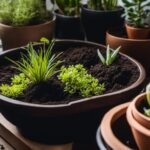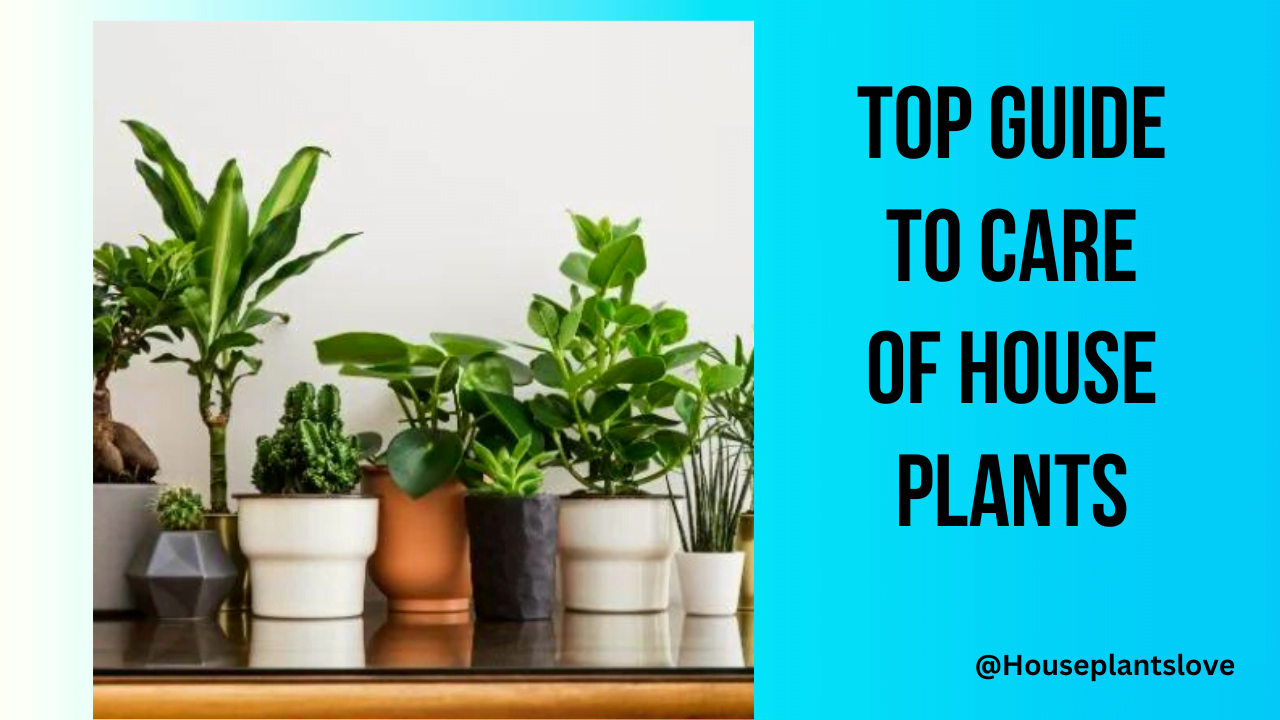As a plant enthusiast, I am always on the lookout for the latest trends in indoor gardening. With 2024 just around the corner, I’m excited to share with you the hottest indoor plants that will elevate your home decor and bring nature’s beauty inside.
So, what can you expect in terms of houseplants in 2024? Well, I’ve done my research and found the most popular indoor plants that are set to take the gardening world by storm. From stunning foliage to air-purifying qualities, these plants are the best houseplants for 2024.
If you’re looking to stay ahead of the curve and transform your space into a lush oasis, keep reading to discover the trending houseplants for 2024.
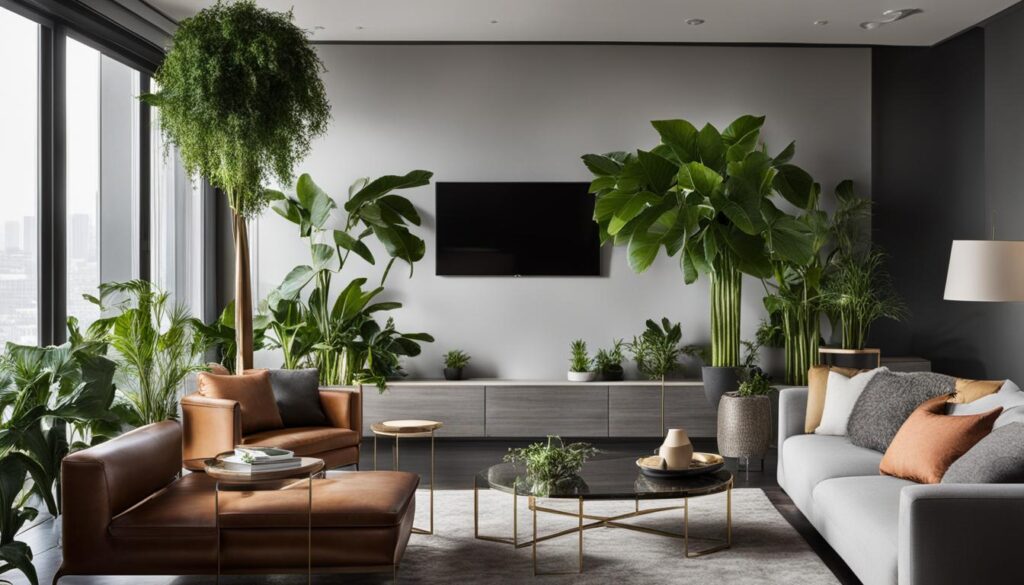
Top Trending 2024 Indoor Plants & Must-Haves
What is Calathea and How Does it Purify the Air?
Calathea is an exquisite tropical plant native to South America. With its vibrant foliage and unique patterns, it adds a touch of natural beauty to any indoor space. Calathea is not only visually appealing but also highly beneficial for purifying the air.
Like other air-purifying plants, Calathea has the remarkable ability to remove harmful chemical compounds from the environment. It acts as a natural air purifier, eliminating pollutants such as those found in cigarette smoke and cleaning solvents. By absorbing these toxins, Calathea helps to improve the indoor air quality, making it fresher and healthier to breathe.
The air-purifying properties of Calathea make it an excellent choice for individuals with allergies or asthma. Its ability to filter out impurities can help reduce respiratory issues and promote better breathing. This tropical plant not only adds aesthetic appeal but also contributes to a cleaner and more comfortable living space.

If you’re looking to enhance both the visual appeal and air quality in your home, Calathea is an ideal choice. Its tropical origins make it well-suited for indoor environments, and its air-purifying qualities ensure a healthier atmosphere. When caring for Calathea, provide it with the right amount of humidity and indirect sunlight to help it thrive and perform its air-purifying magic.
How to Care for Calathea
When it comes to caring for calathea, a tropical plant with stunning foliage, there are a few key factors to keep in mind. By following these care tips, you can ensure that your calathea thrives and remains healthy in your indoor space.
Provide the Right Lighting
Calathea plants prefer bright, indirect sunlight. Placing them near a north or east-facing window is ideal, as they can get the required light without being exposed to direct sunlight, which can scorch their delicate leaves. If you don’t have access to bright natural light, you can also use fluorescent lights to provide adequate illumination for your calathea.
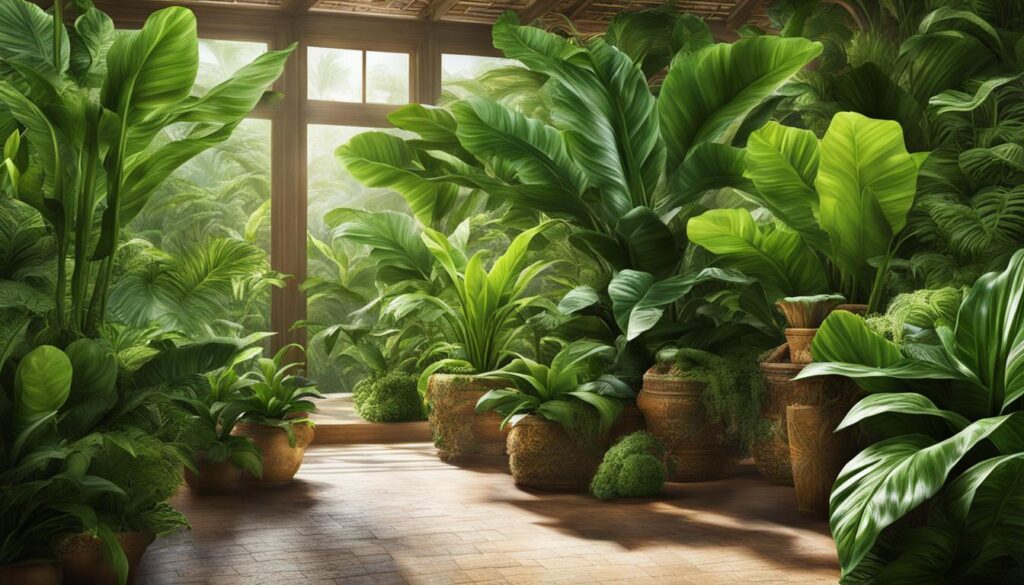
Ensure Warmth and Humidity
Calathea plants thrive in warm, humid environments. They prefer temperatures ranging between 65 and 75 degrees Fahrenheit. Avoid placing them in areas with temperature fluctuations or drafts, as these can stress the plant. To create the right humidity levels, you can use a humidifier, place the plant on a tray filled with water and pebbles, or mist the leaves regularly. This tropical plant will appreciate the added moisture in the air.
Keep the Soil Moist and Well-Drained
Calathea plants require consistently moist soil, but overwatering can lead to root rot. Water your calathea when the top inch of the soil feels slightly dry, but be sure not to let the soil completely dry out. Use well-draining potting soil that retains moisture while allowing excess water to flow out. You can also add peat moss or coco coir to the soil mix to enhance its ability to retain moisture.
Use Rainwater or Distilled Water
Calathea plants can be sensitive to the minerals present in tap water. To avoid any potential damage, it is best to water your calathea with rainwater or distilled water. You can collect rainwater in a container or purchase distilled water from a store. This will help maintain the health and vitality of your calathea’s leaves.
By following these care guidelines for calathea, you can ensure that this tropical plant remains healthy and vibrant in your indoor space. With its attractive foliage and air-purifying qualities, calathea is a wonderful addition to any plant lover’s collection.
Other Trending Indoor Plants for 2024
In addition to the popular calathea, there are several other houseplants that are trending for 2024. These plants not only add a touch of greenery to your indoor space but also require minimal care, making them perfect for both beginners and experienced plant enthusiasts.
- One of the top choices for 2024 is the fiddle leaf fig. Known for its large, glossy leaves, this plant adds a statement to any room. It thrives in bright, indirect light and prefers to be placed near a window.
- The monstera deliciosa, also known as the Swiss cheese plant, is another trending option. Its unique perforated leaves make it a striking focal point in any space. This plant can tolerate a range of light conditions and requires moderate watering.
- Pothos, also known as devil’s ivy, is a versatile and easy-care plant. It features heart-shaped leaves and can be displayed in hanging baskets or trained to climb a trellis or wall. Pothos thrives in a variety of light conditions and can tolerate periods of dry soil.
- For those looking for low-maintenance plant options, the snake plant is an excellent choice. Its long, upright leaves with variegated patterns add a modern touch to any room. Snake plants are known for their air-purifying properties and can thrive in both bright and low-light conditions.
- The zz plant, also known as Zamioculcas zamiifolia, is a popular choice for its tolerance of low light and neglect. Its glossy, dark green leaves and upright growth make it a stylish addition to any space. This plant is drought-tolerant and only requires occasional watering.
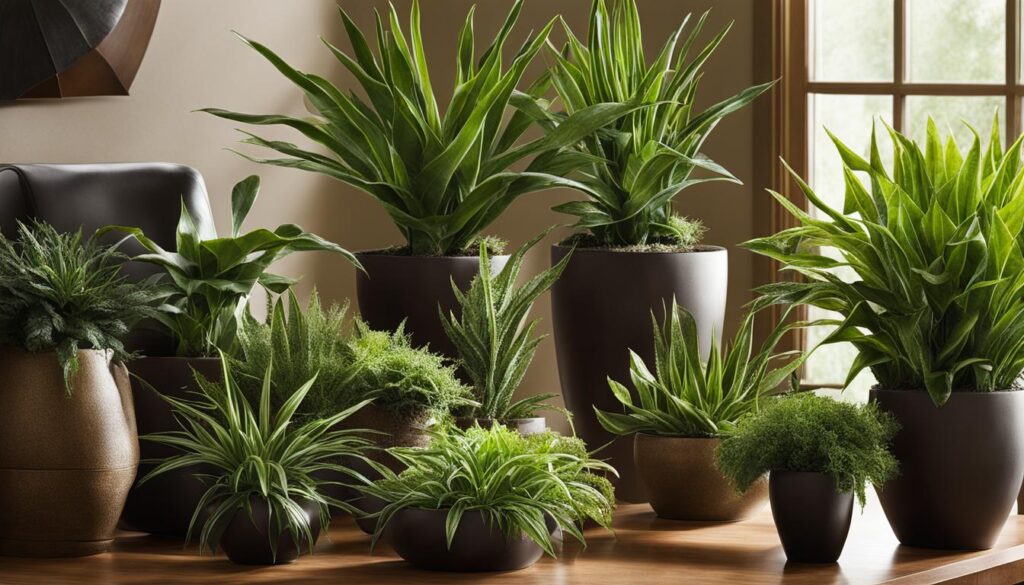
Placement and Light Requirements for Indoor Plants
When it comes to creating a thriving indoor garden, understanding the placement and light requirements of your houseplants is crucial. Different plants have varying needs when it comes to light, and providing the right conditions will ensure their growth and overall well-being.
Consider the Light Preferences
Indoor plants can be categorized into three general light preferences: bright, indirect light; moderate, filtered light; and low-light conditions.
Plants that thrive in bright, indirect light:
- Calathea (see image below)
- Fiddle Leaf Fig
- Monstera Deliciosa
- Rubber Plant
Plants that prefer moderate, filtered light:
- Pothos
- Peace Lily
- Spider Plant
- ZZ Plant
Plants suitable for low-light conditions:
- Snake Plant
- Chinese Evergreen
- Cast Iron Plant
- Parlor Palm
Placing Your Indoor Plants
Now that you’re familiar with the light preferences of different houseplants, it’s time to find the perfect spot for each of them.
Plants that require bright, indirect light should be placed near windows where they can receive ample sunlight. Be mindful of any curtains or blinds that might obstruct the light and adjust them accordingly.
If your plants prefer moderate, filtered light, you can place them a bit further away from the windows to protect them from direct sun exposure. Consider using sheer curtains or placing them in areas where the light is diffused.
For low-light plants, you can position them in spaces that receive minimal natural light. They can thrive in areas like hallways, bathrooms, or corners of the room that are farther away from windows.
Remember, it’s essential not to overcrowd your plants in a single location. Allow enough space for proper air circulation and growth. Also, periodically rotate the positioning of your plants to ensure all sides receive equal light exposure.
By carefully considering the light requirements and placing your indoor plants accordingly, you’ll be setting them up for long-term success and a vibrant display in your home.
Choosing the Right Pots for Indoor Plants
When it comes to caring for your indoor plants, choosing the right pots is essential for their health and overall aesthetic appeal. The right pots not only provide a suitable environment for plant growth but also enhance the overall look of your indoor greenery. Here are some crucial factors to consider when selecting pots for your indoor plants:
Pot Drainage
It is highly recommended to choose pots with drainage holes to prevent waterlogging and root rot. Adequate drainage is essential as it allows excess water to escape, ensuring the plant’s roots don’t sit in stagnant water, which can lead to various issues. Proper drainage promotes healthy root development and prevents the buildup of excess moisture.
Size Matters
The size of the pot plays a significant role in your plant’s growth and well-being. It’s important to choose a pot that is appropriate for the plant’s root system. A pot that’s too small can restrict root growth, impacting the overall health of the plant. On the other hand, a pot that’s too large can lead to overwatering and waterlogged soil. Be mindful of choosing a pot that allows your plant’s roots to spread comfortably but without excessive space.
Showcasing Style with Decorative Pots
While functionality is crucial, decorative pots can also add style and personality to your indoor greenery. Opt for plant containers that complement your home’s interior decor and reflect your personal taste. Decorative pots come in various materials, colors, and designs, allowing you to find the perfect match for your indoor plants. Just ensure that decorative pots also provide proper drainage to maintain optimal plant health.
Benefits of Indoor Plants
Indoor plants not only add beauty to your home but also offer a multitude of benefits of indoor plants that go beyond aesthetics. Let’s take a closer look at why incorporating indoor plants into your living space can have a positive impact on your well-being and environment.
Purifying the Air and Improving Indoor Air Quality
One of the key advantages of having indoor plants is their ability to purify the air we breathe. They act as natural air filters, removing toxins and pollutants from the surrounding environment. Through a process called photosynthesis, indoor plants absorb carbon dioxide and release oxygen, promoting cleaner and fresher air. By reducing the presence of harmful substances, such as formaldehyde and benzene, indoor plants contribute to better indoor air quality, resulting in a healthier living space for you and your loved ones.
- Indoor plants remove toxins and pollutants from the air
- They release oxygen, promoting cleaner and fresher air
- Improved indoor air quality for a healthier living space
Increasing Humidity Levels
Indoor environments, particularly during dry seasons or in areas with low humidity, often lack moisture. This can lead to discomfort, dry skin, and respiratory issues. Indoor plants can help combat these problems by releasing water vapor into the air through a process known as transpiration. By naturally increasing humidity levels, indoor plants create a more comfortable and pleasant living environment.
- Indoor plants release moisture, increasing humidity levels
- Improved comfort and reduced dryness
Reducing Stress and Boosting Mood
The presence of indoor plants has been linked to a decrease in stress levels and an improvement in overall mood. Being in the presence of nature and greenery has a calming effect on the mind and body, promoting relaxation and reducing feelings of anxiety and tension. Indoor plants create a sense of tranquility and well-being, helping you unwind after a long day and fostering a positive atmosphere in your home.
- Indoor plants create a calming and soothing ambiance
- Reduction in stress levels and feelings of anxiety
- Improved overall mood and well-being
Enhancing Focus and Productivity
Studies have shown that indoor plants can have a positive impact on cognitive function, concentration, and productivity. The presence of greenery in your workspace or study area can help improve focus and attention, making tasks more manageable and increasing your efficiency. Indoor plants create a visually appealing and stimulating environment that promotes creativity and concentration.
- Indoor plants enhance focus and cognitive function
- Increased productivity and efficiency
- Stimulated creativity and concentration
So, consider adding some indoor greenery to your home to enjoy these numerous benefits. From cleaner air and increased humidity to reduced stress levels and improved focus, indoor plants can truly transform your living space into a haven of well-being and positivity.
Easy Care Indoor Plants for Beginners
If you’re new to caring for indoor plants, don’t worry! There are plenty of easy-care houseplants that are perfect for beginners. These low-maintenance indoor plants require minimal attention and can thrive in various conditions, making them ideal for those who are just starting their green journey.
Pothos
is a popular choice among beginner-friendly houseplants. It features beautiful, trailing vines that can add a touch of greenery to any room. Pothos are known for their resilience and ability to tolerate a wide range of light levels, from bright sunlight to low light. They also require minimal watering and can even survive occasional neglect, making them perfect for busy individuals.
Snake Plant
Snake plants, also known as Sansevieria or mother-in-law’s tongue, are incredibly hardy and virtually indestructible. They can thrive in almost any environment, from low light to bright, indirect sunlight. Snake plants have thick, upright leaves that come in a variety of colors, adding a unique and stylish touch to your indoor space. With their ability to purify the air and improve indoor air quality, snake plants are a fantastic choice for beginner plant parents.
Spider Plant
Spider plants are another excellent option for beginners. These houseplants are known for their arching leaves that feature green and white stripes or solid green coloration. Spider plants are extremely adaptable and can tolerate a range of light conditions, making them suitable for different areas in your home. They also produce small, offshoots called “spiderettes,” which can be propagated into new plants, allowing you to expand your indoor plant collection with ease.
Peace Lily
Peace lilies are not only beautiful but also incredibly low-maintenance. These elegant houseplants feature dark green leaves and stunning white flowers, adding a touch of elegance to any space. Peace lilies thrive in low to medium light conditions, making them perfect for rooms with limited natural sunlight. They also have the unique ability to let you know when they need watering by drooping their leaves, making it easy to determine the right time for hydration.
With these easy care houseplants, you can confidently embark on your indoor gardening journey. Whether you choose pothos, snake plant, spider plant, or peace lily, these low-maintenance indoor plants will bring beauty and greenery to your home with minimal effort.
Final Thoughts on 2024 Trending Indoor Plants
As we look ahead to 2024, I am excited to share my final thoughts on the houseplant trends that will continue to captivate indoor gardeners. Indoor plants have become more than just decorative elements; they have become an integral part of designing a green and vibrant living space. Whether you are a seasoned plant lover or just starting your indoor gardening journey, incorporating these trending plants into your home will elevate the overall aesthetic and create a soothing sanctuary.
One of the standout plants for 2024 is the calathea. Known for its striking striped leaves and vibrant colors, the calathea adds an instant touch of natural beauty to any room. Not only is it visually appealing, but the calathea also purifies the air, making it a perfect choice for those seeking both style and function in their indoor oasis.
While the calathea takes the spotlight, other plants such as the fiddle leaf fig and monstera deliciosa continue to dominate interior design trends. The fiddle leaf fig’s large, lush leaves create an impressive focal point, while the monstera deliciosa’s unique split leaves make a bold statement in any space. These plants, along with various other popular options, offer a wide range of choices to suit different preferences and styles.
When bringing these trending indoor plants into your home, it is essential to consider their specific care requirements. Each plant has its own preferences for sunlight, moisture levels, and humidity. By understanding and meeting these needs, you can ensure their well-being and optimize their growth. Additionally, choosing the right pots with proper drainage and finding the ideal placement within your home will contribute to the overall success of your indoor garden.
In conclusion, embracing the 2024 indoor plant trends allows you to create an environment that is not only visually appealing but also promotes well-being and relaxation. By incorporating plants like calathea, fiddle leaf fig, and monstera deliciosa, you can transform your home into a sanctuary that brings nature indoors. So, start exploring these trending indoor plants, unleash your creativity, and enjoy the many benefits that they offer.
FAQ
What are the benefits of keeping indoor plants?
Indoor plants offer numerous benefits, including reduced stress levels, improved focus, enhanced well-being, increased productivity, and better indoor air quality.
What is the calathea plant and how does it purify the air?
Calathea is a tropical plant that purifies the air by removing harmful chemical compounds, such as those found in cigarette smoke and cleaning solvents. It releases oxygen and increases humidity levels, making it beneficial for individuals with allergies or asthma.
How do I care for calathea?
Calathea prefers bright, indirect sunlight, warmth, and high humidity. It should be watered consistently to keep the soil moist but not overly wet. Using potting soil that retains moisture and drains well is recommended. Watering with rainwater or distilled water is best to avoid sensitivity to minerals in tap water. It should also be placed in an area with temperatures above 65 degrees Fahrenheit to protect it from drafts.
What are some other trending indoor plants for 2024?
Some other trending indoor plants for 2024 include fiddle leaf fig, monstera deliciosa, pothos, snake plant, and zz plant. These plants are known for their aesthetic appeal and low-maintenance care requirements.
How should I place indoor plants and what are their light requirements?
When placing indoor plants, it is important to consider their specific light requirements. Some plants thrive in bright, indirect light, while others prefer low-light conditions. Plants that require bright light should be placed near windows, while those that prefer low light can be positioned away from direct sunlight.
How do I choose the right pots for my indoor plants?
It is recommended to choose pots with drainage holes to prevent waterlogging and root rot. Consider the size of the pot, ensuring it is appropriate for the plant’s root system. Decorative pots can add style to your indoor greenery, but make sure they also provide proper drainage for optimal plant growth.
What are the benefits of indoor plants?
Indoor plants purify the air by removing toxins and releasing oxygen, improving indoor air quality. They also release moisture, increasing humidity levels in dry environments. Additionally, they have been shown to reduce stress, boost mood, and improve focus, creating a calming and soothing ambiance in your living space.
What are some easy-care indoor plants for beginners?
Some easy-care indoor plants for beginners include pothos, snake plant, spider plant, and peace lily. These plants are known for their resilience and ability to thrive in various conditions. They require minimal watering and can tolerate a range of light levels, making them perfect for beginners.
What are the final thoughts on 2024 trending indoor plants?
As we look ahead to 2024, indoor plants continue to be a popular trend for creating a green and vibrant living space. Whether you choose the trendy calathea or opt for other popular options like fiddle leaf fig or monstera deliciosa, indoor plants can transform your home into a lush oasis. Remember to consider their specific care requirements, placement, and pot selection for optimal growth. Enjoy the many benefits that indoor plants bring, both in terms of aesthetics and well-being.

